The Google Nexus 5X Review
by Brandon Chester on November 9, 2015 8:00 AM EST- Posted in
- Smartphones
- LG
- Mobile
- Android 6.0
- Nexus 5X
Display
A smartphone's display is unquestionably one of its most important aspects, and failing to deliver a good display can be a fatal flaw for a device. If the screen doesn't have sufficiently high brightness and contrast then its usability with high ambient lighting will be severely crippled. Inaccurate color rendition will cause photos and videos that are taken and viewed on the device to look radically different from other devices. Pushing a wide color gamut can also have ramifications that go beyond making the display inaccurate, such as reducing battery life on AMOLED devices by having to drive a higher voltage in order to achieve the wider gamut.
Last year's Nexus 6 ended up being a significant disappointment as far as the display was concerned. It was immediately obvious to me that the gamut was far too large, and that peak brightness was too low. My testing confirmed both of these things, and I was disappointed mainly because the Nexus 5 from the previous year sold for significantly less than the Nexus 6, and sported imperfect but relatively good display calibration. While this year's Nexus 6P is an AMOLED display that we are yet to test, the Nexus 5X sports an IPS LCD like its predecessor. At 5.2", this year the display is a bit bigger than the 4.95" Nexus 5, but it's still a far cry from the 5.96" display that was on the Nexus 6.
To analyze the quality of the Nexus 5's display I've run it through our standard display testing suite. As always, displays are calibrated to 200nits of brightness, and results are measured with an i1Pro 2 spectrophotometer, and managed using SpectraCal's CalMAN 5 software. Contrast measurements are done with an i1Display Pro colorimeter due to the i1Pro 2's more limited accuracy with very low brightness levels.
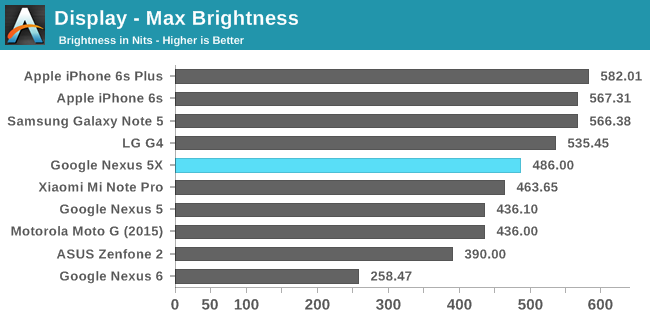

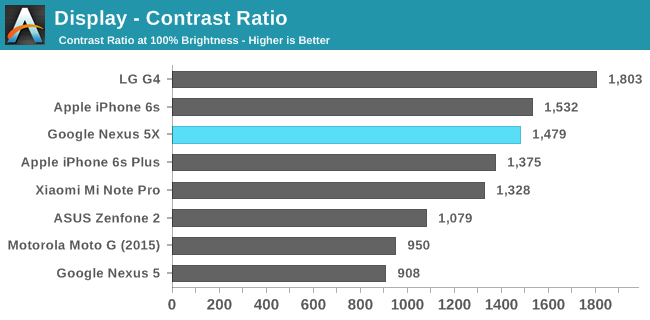
The most basic data point to examine when moving beyond resolution is a display's maximum brightness and its contrast ratio. The Nexus 5X does very well here, with a peak brightness of 486 nits, and a minimum black level of 0.32 nits, which leads to a contrast ratio of 1479:1. This is the result of the use of photo-alignment to influence subpixel orientations and reduce light leakage, which results in deeper blacks and thus a higher contrast ratio. While many other LCD-based smartphones are also using this technology, to see it applied to a $379 smartphone is very exciting. The display's maximum brightness is also a healthy improvement over the Nexus 5, and I haven't run into any situations where the display can't get bright enough to counter glare from the cover glass.
Something that doesn't really show up in any of our figures is the visibility of the display's capacitive sensors. On the Nexus 5 these were fairly noticeable when there was any light shining on the display, and this is unchanged on the Nexus 5X. This is something that can be observed on every device with capacitive touch, although on AMOLED devices and iPhones it's extremely hard to see. I only felt it was worth pointing out because it does seem more pronounced on the Nexus 5X than some of the other devices I have.
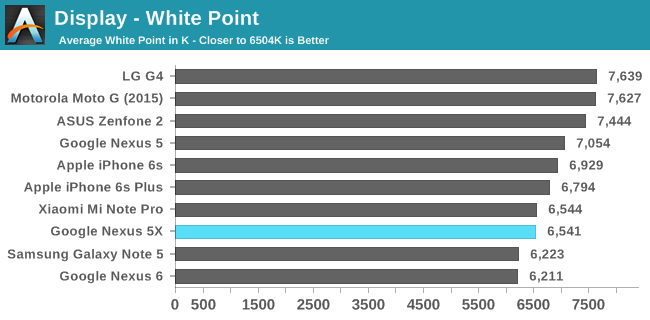
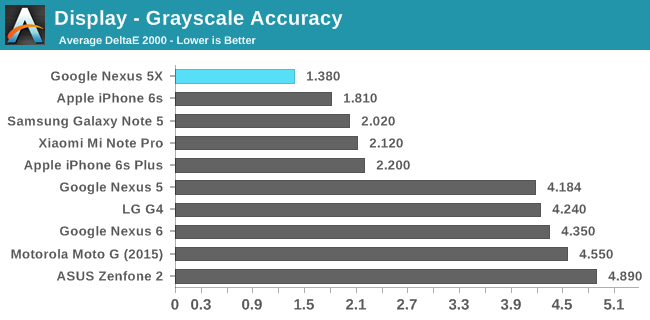
Greyscale accuracy on the Nexus 5 is impeccable. Gamma does tend slightly upward as one moves past the 20% mark, but it's still quite accurate and most greyscale errors are approaching the point where the human eye could not even distinguish them from their reference colors when placed side by side. The RGB component balance for each shade of grey is also very good, and the display's average white point is only ever so slightly above the targeted 6504K. There's not much more to say, as this level of calibration is exceptional for a device of this price. The Nexus 5 certainly had fairly good calibration, but issues with the gamma made the display appear washed out which was a common complaint, and the Nexus 5X resolves that while also boosting accuracy significantly.
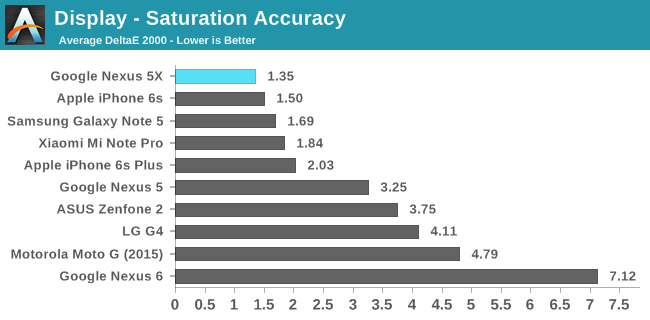
The accuracy for 20% saturation steps on the Nexus 5X is also incredibly high. It's actually the lowest DeltaE on record for a smartphone - lower than even the Galaxy Note5 and iPhone 6s - and there's honestly nothing at all that I could criticize about the rendition of primary and secondary colors on the display. The chart above also shows how much improvement has been made compared to the Nexus 5 and Nexus 6, with the latter being especially bad due to its overly wide gamut.
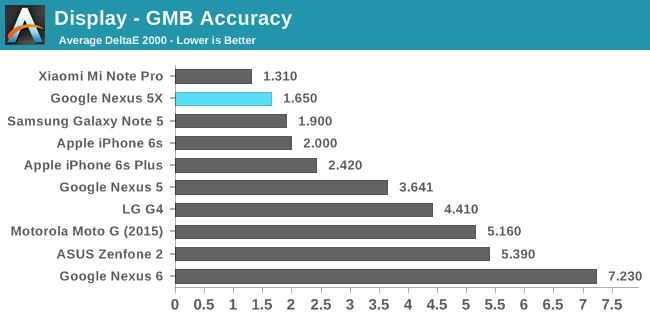
Once again the Nexus 5X provides an incredibly high level of accuracy, with color mixtures being reproduced almost as accurately as primary and secondary colors. It's not the absolute best result on record due to the Mi Note Pro's even higher level of accuracy, but you would only be able to tell that the rendition is wrong if you had the color right beside the reference color with absolutely no motion occurring, and that's well beyond the level of accuracy that is really necessary for a mobile device.
I really don't know what else to say about the Nexus 5X's display, because there's really nothing that can be criticized. I would certainly like if the brightness went up to 600 nits, but I would also prefer that it went to 6000 nits, and obviously that's asking a bit much. As far as LCDs go, the Nexus 5X has one of the best, if not the best that I've seen to date. At this point Google and their OEM partners are going to have to look to gamut as a vector of improvement, but only after proper color management is available at the OS level in order to avoid the problems that have plagued wider gamut displays, which have lacked suitable color management to properly map sRGB content into the wider color space.


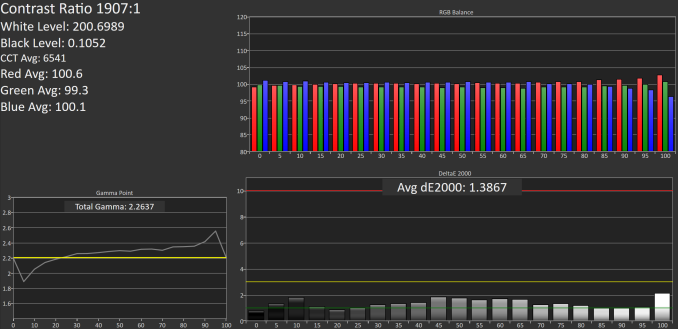
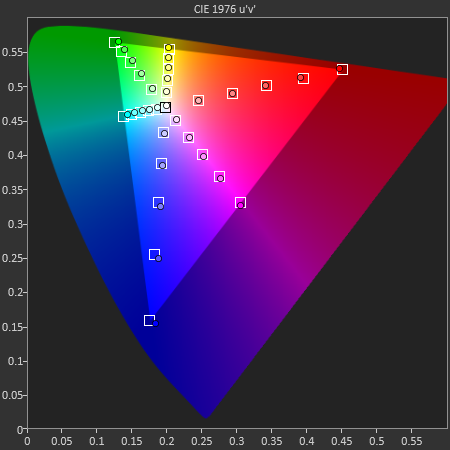









197 Comments
View All Comments
zeeBomb - Monday, November 9, 2015 - link
Same! I'm kinda in that position as well. Maybe a Z5 premium review would be cool too.Bob Todd - Monday, November 9, 2015 - link
As someone with 3 OnePlus Ones in his household, I'd tell you to run like hell toward the Nexus. The software situation is kind of a disaster for OnePlus. Fun bugs like this one where your phone won't really work as a phone for lots of users in VoLTE markets (no cellular when connected to WiFi) that go unfixed for months on end.https://jira.cyanogenmod.org/plugins/servlet/mobil...
The issue affects all 5.x radios so OxygenOS is impacted too. Then there's crap like them not fixing the Google Play Services battery drain bug in other patches even though it was a 10 minute fix in framework-res. It wasn't hard to ignore my invite for the OnePlus Two.
yankeeDDL - Monday, November 9, 2015 - link
I owe a Nexus4 and a Nexus5. Both in service and without an issue for 3 and 2 years respectively.The Nexus5 battery is starting to show signs of aging (I do still get 1 full day without charging if I limit the use, but I need to watch it).
I decided to buy a new one, but the thought of getting a new, better phone, is appealing. I owe the N5 32GB. It baffles me how there are still phones around with 8/16GB, as 32GB feels definitely tight. I guess it depends on the use one does of it, but my photos folder easily goes to 6~8GB in few weeks. Add to this 10GB of music, and there's little space for videos, games and what not. So the OnePlus X with a nice 128GB SD card sees extremely attractive, especially at that price point, using an 801 which does not overheat and does not drain the battery, and a decent size screen.
If it was a Nexus, I would not think twice. But it isn't, hence I looked forward to the N5X.
Problems: only 32GB and in Europe, it is priced at 529eur. That's 570usd. Seriously? Unfortunately, yes. The OnePlus X is nearly half of it (supposedly) and it has an SD card and a larger battery and a slightly smaller screen (a plus, in my opinion). The camera will likely not be up to that of the N5X, but still, I have a real camera when I want to take "nice" photos. To "capture the moment", I'm OK with the N5 so, I suppose, I'd be OK with the One+X.
Thanks for the feedback on One+: I do have some colleagues who have it and they did not seem t have any major problem.
UtilityMax - Monday, November 9, 2015 - link
My OnePlus One has been working great, though I have to say I never bothered to upgrade from the original ROM it shipped with some time in March.UtilityMax - Monday, November 9, 2015 - link
Based on reviews I have seen, OnePlus X suffers from the same shorter (not 5X though) battery life, heat and throttle issues as any other device using the current crop of the 64-bit Snapdargon SoCs. I have heard from a bunch of people already that they'd rather hang onto their old phones than buy the ones with the current 64-bit Snapdragon SoCs. I have one OnePlus One phone in the family, and I have to agree with them. The One is still a fantastic phone, and you can buy the 64GB version for $300 in the USA, no invites necessary.If you do want to buy one of those two, OnePlus X seems like a nice deal on paper, in the sense that all specs look slightly better.
UtilityMax - Monday, November 9, 2015 - link
Err.. sorry, I was talking about OnePlus 2 above. The OnePlus X is an excellent smart phone, but unfortunately it lacks the bands for optimal LTE service in the USA.DukeN - Monday, November 9, 2015 - link
Good job as always not giving two fucks about non-Apple devices Anandtech.Apple devices - reviews on the first day of release/reveal.
Anything else - we'll get around to it (This is like five weeks after the first reveal). And uh, maybe should have reviewed the 6P which is probably the best handset around?
No wonder this place is in the toilet relative to a few years back.
Brandon Chester - Monday, November 9, 2015 - link
The iPhone 6s was released on Sept 25, our review went up on Nov 2. The Nexus 5X was released on Sept 29, and this review has gone up on Nov 9. Accounting for the fact that we don't publish on weekends the gap was the same. I don't see how we give preference to Apple devices at all.Furthermore, I received the 5X well after other publications did, and Google didn't send a 6P along with it. We just sourced one from Huawei and so that review will take some time to do properly. Google's lack of organization in getting press hardware and software in a timely manner is why, for example, I can have an iOS review done for launch day but not an Android Marshmallow one.
Also, if you're going talk about things a few years back I suggest you look at how long the HTC One M7 review took. Doing things right takes time, and there are lots of other places to get a 24 hour review.
trekinator - Monday, November 9, 2015 - link
Thanks Brandon. Most of us appreciate the time it takes to do things right.bw13121 - Monday, November 9, 2015 - link
I'll second that. Fantastic quality and in depth review. There are those of us who do appreciate the quality and technical depth of your reviews, as most reviews are that light on detail they are useless!